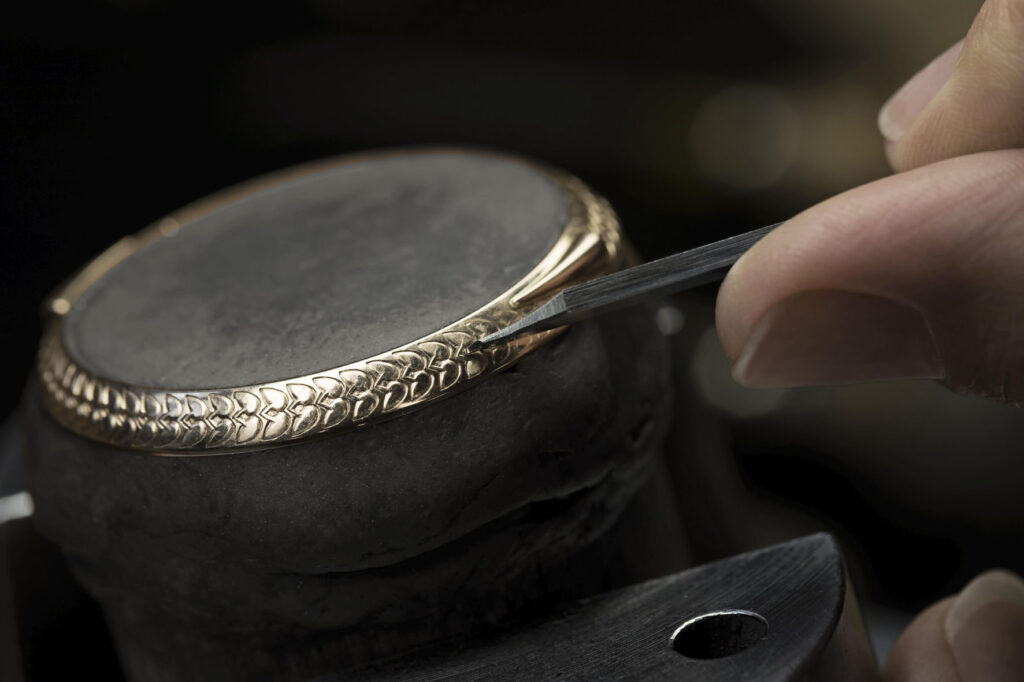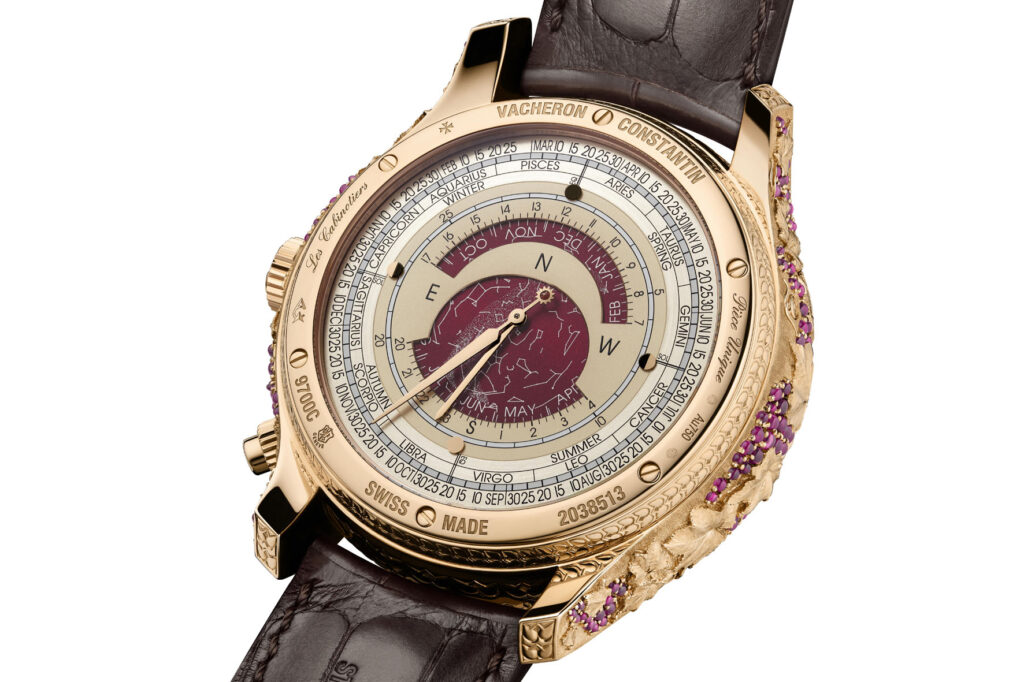Vacheron Constantin: Les Cabinotiers Grande Complication Bacchus
10 January 2022In the Vacheron Constantin universe, Les Cabinotiers represents a department in its own right dedicated to the personalisation of Grand Complication models and single-piece editions. Each year, the Les Cabinotiers department unveils a range of single-piece editions relating to a theme cherished by Vacheron Constantin. The year 2021 was dedicated to “Le Temps Céleste” (which means Celestial Time), with timepieces referring to the astronomical origins of time measurement.
The single-piece edition Les Cabinotiers Grande Complication Bacchus combines Vacheron Constantin’s expertise in grand complication watches with its mastery of artistic crafts. This double-sided wristwatch comprises 16 complications, essentially astronomical and calendar-related, powered by Calibre 2755 GC16 with minute repeater and tourbillon. A technical feat housed in an 18K 5N gold case whose middle is sculpted in bas-relief. In tribute to the god of vines and wine, this “Bacchus” watch finds another source of inspiration in Johannes Kepler, resulting in a captivating association between mythology and astronomy.

THE DECORATIONS
The 18K 5N pink gold case of this Les Cabinotiers timepiece features a decoration composed of vine leaves interspersed with bunches of ruby grapes. The engraver’s work is complemented by that of the gem-setter on the outside of the case in giving life to figurative motifs, making this watch a piece of fine craftsmanship. The two master artisans working on this model took turns, with the gem-setter first taking the case from the engraver’s hands and then returning it for the last finishing touches, a progressive duet-style operation that required more than 300 hours of combined dexterity.

The case decoration continues on the bezel and case-back with a hand engraving depicting vine leaves. The difficulty implied by this intaglio engraving lies in the absence of a border or contour line. Hollowed out across the entire width of the bezel, the garland thus stands alone thanks to the metronomic regularity of the motif. This latter aspect is picked up on the two fastening options – folding clasp and pin buckle – accompanying the watch and which required a full week’s work in themselves.

THE MANUAL WINDING CALIBRE 2755 GC16
To create the movement of this highly complicated watch, Vacheron Constantin’s watchmakers took the Tour de l’Île as a reference, a timepiece presented in 2005 as a tribute to 250 years of watchmaking expertise cultivated by the Geneva-based Manufacture. In the same spirit, the Les Cabinotiers – Bacchus timepiece combines 16 complications, making it one of the most complex watches produced by the Maison. For the sake of precision timekeeping, its manual winding Calibre 2755 GC16 is equipped with a tourbillon regulator to compensate for the effects of the earth’s gravity on the mechanism. Featuring a cage shaped like Vacheron Constantin’s signature Maltese cross emblem, the tourbillon completes one full rotation per minute, thus serving as a small seconds indicator. This watch also incorporates a minute repeater chiming the hours, quarters and minutes on demand. To avoid unnecessary noise as well as wear and tear on the mechanism, the striking of the gongs is equipped with an ingenious centripetal flying strike regulator. This perfectly silent device regulates the duration of the musical sequences so as to obtain clear, distinct and regular sounds.

The calendar and astronomical functions play a starring role on both sides of the watch. On the front, where the mechanical ballet of the tourbillon can be admired at 6 o’clock, the perpetual calendar indications are displayed on three counters. Positioned in the upper part of the dial, they respectively show the date, day and month. Designed to keep track of the Gregorian calendar’s vagaries without any need for adjustment until 2100, this horological complication is further enhanced by the indication of the leap-year cycle. The latter appears in a small aperture next to the hand indicating the torque of the minute repeater mechanism between 1 and 2 o’clock. This striking mechanism power reserve is matched by an indication of the movement power reserve, which can be read by means of a serpentine pointer coaxial with the day of the week hand.

The complex mechanics of this piece also provide an astronomical reading of time representing a tribute to Johannes Kepler, regarded as one of the founders of modern astronomy for having discovered the laws of planetary motion, in perfect agreement with Copernicus’ heliocentric hypotheses. The first astronomical functions thus appear on this same opaline champagne-coloured dial, starting with the equation of time positioned between 10 and 11 o’clock. As the Earth’s path around the Sun is not circular but elliptical, and since the Earth’s axis is inclined at 24° to the plane of its orbit, the time between two zenith passages of the Sun is not the same throughout the year. This difference between the (true) solar day and the (average) 24-hour civil day ranges from -16 to +14 minutes depending on the time of year and coincides only four times a year. Called the equation of time, or time correction in astronomical language, this differential is displayed by a dedicated pointer, while sunrise and sunset times – adjusted according to a reference city – appear at the bottom of the dial.

An astronomical watch as conceived by the watchmakers at Vacheron Constantin would not be complete without a sidereal time indication. This display finds its place the back of the watch in the shape of a rotating disc depicting the celestial vault with its constellations observable from the Northern hemisphere. Taking a fixed star in the sky as a reference point, the time required for the Earth to complete a full 360° rotation, or sidereal day, is exactly 23 hours, 56 minutes and 4 seconds. Since the Earth is both spinning on its axis and revolving around the Sun, it takes about four minutes less than a calendar day to return to its point of origin relative to a given star. On this model, the “celestial” disc thus performs a complete rotation according to sidereal time with the time displayed on the periphery, opposite the date appearing on the periphery of the mobile disc. This same date is read off by a large central hand moving over the fixed outer flange bearing a scale graduated in five-day increments. This hand also indicates the sign of the zodiac, the season and the four dates corresponding to the solstices and equinoxes. Finally, the small central hand indicates the age of the moon, i.e. the number of days that have elapsed since the last full moon.

Comprising 839 parts and measuring a total 33.90 mm in diameter and 12.15 mm thick, this movement endowed with a 58-hour power reserve represents a technical feat that is all the rarer in that it displays all its functions in a perfectly legible manner on both sides. Equipped with a balance oscillating at a rate of 18,000 vibrations per hour (2.5 Hz), it is housed in a 47 mm-diameter 18K 5N pink gold case, of which the characteristics been specifically designed to provide the best possible sound quality for the minute repeater.
